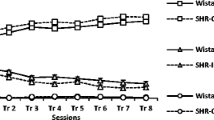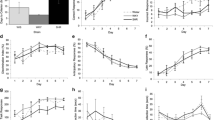Abstract
The spontaneously hypertensive rat (SHR) is the most commonly used model of attention-deficit hyperactivity disorder (ADHD), displaying the main symptoms of the disorder which are responsive to psychostimulant treatments. Research to date has focused on behavioural tests investigating functioning of the striatum or prefrontal cortex in these rats. However, there is now evidence that the superior colliculus, a structure associated with head and eye movements, may also be dysfunctional in ADHD. Therefore, the aim of this study was to investigate whether the SHR demonstrated impairment in collicular-dependent behaviour. To this end, we examined air righting behaviour, which has previously been shown to be modulated in a height-dependent manner reliant on a functional superior colliculus. We assessed SHR, Wistar Kyotos and Wistars on static righting and air righting at 50 and 10 cm drop heights. There were no differences in static righting, indicating that there were no gross motor differences that would confound air righting. Qualitative analysis of video footage of the righting did not reveal any changes previously associated with collicular damage, unique to the SHR. However, the SHR did show impairment in height-dependent modulation of righting in contrast to both control strains, such that the SHR failed to modulate righting latency according to drop height. This failure is indicative of collicular abnormality. Given that many rodent tests of attentional mechanisms involve head and eye orienting, which are heavily dependent on the colliculus, a collicular dysfunction has strong implications for the type of attentional task used in this strain.


Similar content being viewed by others
References
Barkley RA, Ullman DG (1975) A comparison of objective measures of activity and distractibility in hyperactive and nonhyperactive children. J Abnorm Child Psychol 3:231–244
Biederman J, Faraone SV (2005) Attention-deficit hyperactivity disorder. Lancet 366:237–248
Binns KE, Salt TE (2000) The functional influence of nicotinic cholinergic receptors on the visual responses of neurones in the superficial superior colliculus. Vis Neurosci 17:283–289
Biscaldi M, Gezeck S, Stuhr V (1998) Poor saccadic control correlates with dyslexia. Neuropsychologia 36:1189–1202
Bower TGR, Broughton JM, Moore MK (1970) Infant responses to approaching objects: an indicator of response to distal variables. Percept Psychophys 9:193–196
de Monasterio FM (1978) Properties of concentrically organized X and Y ganglion cells of macaque retina. J Neurophysiol 41:1394–1417
Dean P, Redgrave P, Westby GW (1989) Event or emergency? Two response systems in the mammalian superior colliculus. Trends Neurosci 12:137–147
Dommett EJ, Overton PG, Greenfield SA (2009) Drug therapies for attentional disorders alter the signal-to-noise ratio in the superior colliculus. Neuroscience 164:1369–1376
Drolet G, Proulx K, Pearson D, Rochford J, Deschepper CF (2002) Comparisons of behavioral and neurochemical characteristics between WKY, WKHA, and Wistar rat strains. Neuropsychopharmacology 27:400–409
Frens MA, Suzuki Y, Scherberger H, Hepp K, Henn V (1998) The collicular code of saccade direction depends on the roll orientation of the head relative to gravity. Exp Brain Res 120:283–290
Gaymard B, Francois C, Ploner CJ, Condy C, Rivaud-Pechoux S (2003) A direct prefrontotectal tract against distractibility in the human brain. Ann Neurol 53:542–545
Goodale MA, Foreman NP, Milner AD (1978) Visual orientation in the rat: a dissociation of deficits following cortical and collicular lesions. Exp Brain Res 31:445–457
Gowan JD, Coizet V, Devonshire IM, Overton PG (2008) D-amphetamine depresses visual responses in the rat superior colliculus: a possible mechanism for amphetamine-induced decreases in distractibility. J Neural Transm 115:377–387
Grantyn A, Moschovakis AK, Kitama T (2004) Control of orienting movements: role of multiple tectal projections to the lower brainstem. Prog Brain Res 143:423–438
Grasse KL, Douglas RM, Mendelson JR (1993) Alterations in visual receptive fields in the superior colliculus induced by amphetamine. Exp Brain Res 92:453–466
Gurney K, Prescott TJ, Redgrave P (2001) A computational model of action selection in the basal ganglia. I. A new functional anatomy. Biol Cybern 84:401–410
Hernandez CM, Hoifodt H, Terry AV Jr (2003) Spontaneously hypertensive rats: further evaluation of age-related memory performance and cholinergic marker expression. J Psychiatry Neurosci 28:197–209
Ignashchenkova A, Dicke PW, Haarmeier T, Thier P (2004) Neuron-specific contribution of the superior colliculus to overt and covert shifts of attention. Nat Neurosci 7:56–64
Katyal S, Zughni S, Greene C, Ress D (2010) Topography of covert visual attention in human superior colliculus. J Neurophysiol 104:3074–3083
Klein CH, Raschke A, Brandenbusch A (2003) Development of pro- and antisaccades in children with attention-deficit hyperactivity disorder (ADHD) and healthy controls. Psychophysiology 40:17–28
Lee PH, Helms MC, Augustine GJ, Hall WC (1997) Role of intrinsic synaptic circuitry in collicular sensorimotor integration. Proc Natl Acad Sci USA 94:13299–13304
Lei Y, Yaroslavsky I, Tejani-Butt SM (2009) Strain differences in the distribution of N-methyl-d-aspartate and gamma (gamma)-aminobutyric acid-A receptors in rat brain. Life Sci 85:794–799
McHaffie JG, Stanford TR, Stein BE, Coizet V, Redgrave P (2005) Subcortical loops through the basal ganglia. Trends Neurosci 28:401–407
Milner AD, Foreman NP, Goodale MA (1978) Go-left go-right discrimination performance and distractibility following lesions of prefrontal cortex or superior colliculus in stumptail macaques. Neuropsychologia 16:381–390
O’Driscoll GA, Depatie L, Holahan AL, Savion-Lemieux T, Barr RG, Jolicoeur C, Douglas VI (2005) Executive functions and methylphenidate response in subtypes of attention-deficit/hyperactivity disorder. Biol Psychiatry 57:1452–1460
Overton PG (2008) Collicular dysfunction in attention deficit hyperactivity disorder. Med Hypotheses 70:1121–1127
Pellis SM, Pellis VC (1994) Development of righting when falling from a bipedal standing posture: evidence for the dissociation of dynamic and static righting reflexes in rats. Physiol Behav 56:659–663
Pellis SM, Pellis VC, Morrissey TK, Teitelbaum P (1989) Visual modulation of vestibularly-triggered air-righting in the rat. Behav Brain Res 35:23–26
Pellis SM, Whishaw IQ, Pellis VC (1991) Visual modulation of vestibularly-triggered air-righting in rats involves the superior colliculus. Behav Brain Res 46:151–156
Pellis SM, Pellis VC, Whishaw IQ (1996) Visual modulation of air righting by rats involves calculation of time-to-impact, but does not require the detection of the looming stimulus of the approaching ground. Behav Brain Res 74:207–211
Redgrave P, Prescott TJ, Gurney K (1999) The basal ganglia: a vertebrate solution to the selection problem? Neuroscience 89:1009–1023
Robinson DL, Kertzman C (1995) Covert orienting of attention in macaques. III. Contributions of the superior colliculus. J Neurophysiol 74:713–721
Sagvolden T, Johansen EB, Woien G, Walaas SI, Storm-Mathisen J, Bergersen LH, Hvalby O, Jensen V, Aase H, Russell VA, Killeen PR, Dasbanerjee T, Middleton FA, Faraone SV (2009) The spontaneously hypertensive rat model of ADHD—the importance of selecting the appropriate reference strain. Neuropharmacology 57:619–626
Spencer TJ, Biederman J, Wilens TE, Faraone SV (2002) Overview and neurobiology of attention-deficit/hyperactivity disorder. J Clin Psychiatry 63(Suppl 12):3–9
Sprague JM, Meikle TH Jr (1965) The role of the superior colliculus in visually guided behavior. Exp Neurol 11:115–146
Stein J, Walsh V (1997) To see but not to read; the magnocellular theory of dyslexia. Trends Neurosci 20:147–152
Swanson JM, Posner M, Potkin S, Bonforte S, Youpa D, Fiore C, Cantwell D, Crinella F (1991) Activating tasks for the study of visual-spatial attention in ADHD children: a cognitive anatomic approach. J Child Neurol 6(Suppl):S119–S127
van den Bergh FS, Bloemarts E, Chan JS, Groenink L, Olivier B, Oosting RS (2006) Spontaneously hypertensive rats do not predict symptoms of attention-deficit hyperactivity disorder. Pharmacol Biochem Behav 83:380–390
Westby GW, Keay KA, Redgrave P, Dean P, Bannister M (1990) Output pathways from the rat superior colliculus mediating approach and avoidance have different sensory properties. Exp Brain Res 81:626–638
Willcutt EG, Pennington BF (2000) Comorbidity of reading disability and attention-deficit/hyperactivity disorder: differences by gender and subtype. J Learn Disabil 33:179–191
Wylie DR, Frost BJ (1990) The visual response properties of neurons in the nucleus of the basal optic root of the pigeon: a quantitative analysis. Exp Brain Res 82:327–336
Yan X, Okito K, Yamaguchi T (2010) Effects of superior colliculus ablation on the air-righting reflex in the rat. J Physiol Sci 60:129–136
Author information
Authors and Affiliations
Corresponding author
Rights and permissions
About this article
Cite this article
Dommett, E.J., Rostron, C.L. Abnormal air righting behaviour in the spontaneously hypertensive rat model of ADHD. Exp Brain Res 215, 45–52 (2011). https://doi.org/10.1007/s00221-011-2869-7
Received:
Accepted:
Published:
Issue Date:
DOI: https://doi.org/10.1007/s00221-011-2869-7




